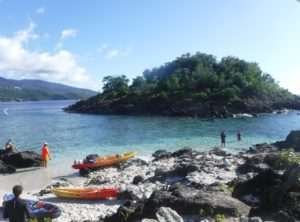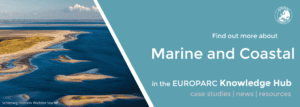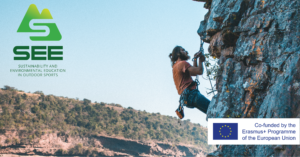Case study: Guide to good behaviour in the marine environment
Photo: Guadeloupe National Park
On this World Ocean Day, we want to share a good practice from our network. One of EUROPARC’s oversees members, the Guadelope National Park, created a guide to good behaviour in order to enhance sustainability of all the activities carried out in their marine protected natural space. Get inspired by their initiative!
Ensuring sustainable & respectful marine outdoor sports
The main mission of the Guadeloupe National Park is to preserve the marine and terrestrial ecosystems located on its territory. Good behaviour and respect of the park’s regulations are necessary conditions for the sustainable exercise of any activity that takes place in this Protected Area.
That’s why the National Park, together with its partners, created a new guide to good behaviour, intended for all users of the marine areas of the National Park.
Read the original case study: Good behaviour in the marine environment: Guadeloupe National Park.
It could be perceived that outdoor sports in the marine environment do not generate such a disturbing effect on the biodiversity present in and around the water, either because of the enormous size of the seas and oceans, or because of the lesser direct contact with the land (in this case the seabed). However, this is not entirely true. The development and promotion of many aquatic activities leads to a clear increase in pressure on marine areas, which are already among those most affected by climate change, especially near the tropics. That is exactly the case in Guadeloupe.
Uncoordinated aquatic activities might generate an impact on species not only under water but also on the surface, such as birds.
Also, in order to carry out some activities such as diving, the transport is done in boats that produce noise, pollute and can destroy the sea bed with their mooring systems.
In response to this situation, it is necessary to communicate and demand responsible and respectful behaviour towards the marine environment from all its users, but especially from professional operators who use the Protected Area to offer their services and develop their activities.
Solutions and actions taken
To tackle the issue, the Park established a system of authorizations for actors who carry out a professional activity inside the Protected Area. These partners were then required to sign agreements through which they commit to respect the Park’s instructions regarding the areas where to operate, as well as rules of behaviour that must be integrated and understood. In order to do this, a benchmarking campaign selected the most suitable operators to work in the area.

Photo: Guadeloupe National Park
The Park created a guide of good behavior, addressed to the general public and compulsory to adhere to for partners authorised to operate in the Marine Protected Area. The set of rules covers a number of sporting activities, with a strong focus on respect for local biodiversity.
Read the set of rules below or download the National Park’s brochure in French!
Eco-responsible behaviour
- bring back my garbage and other people’s garbage
- do not make a fire on the ground
- be quiet
- do not use disposable cutlery
- do not discharge washing and food water
- do not empty grey and black water tanks
- do not feed or disturb the animals
- do not take or manipulate the flora
- respect the whale-watching charter
- do not carry out maintenance work of the vessel at sea
Behaviours related to navigation and anchoring
- have a clean, well-trimmed and serviceable vessel
- limiting greenhouse gas emissions and noise and odour pollution as much as possible
- reduce the speed to 5 knots within 300m of the coastline and mangroves
- use the anchorages
- around the islets (except Pigeon islets), moor the boats (after disembarking passengers) more than 10 meters from the shore (swimming area)
- use anchors only on sandy or muddy areas, anchor and chain outside of meadows – under no circumstances should the mooring line be used in areas of sea grass or coral formations
- do not shift the anchor but raise it vertically
- do not sail in shallow areas where the propellers may damage the seabed
Snorkeling, diving and swimming activities
- do not to touch the fauna and flora
- do not have contact with turtles
- do not to take live or dead animals or plants (e.g. shellfish)
- stay away from bird nests and resting places
- avoid contact with the bottom outside sandy areas
- make a very moderate use of flash and Led lighting and avoid flashing the eyes of animals
- avoid repeated and prolonged passages under overhangs and in caves
- pick up any rubbish discovered
Kayak and sea biking activities
- gather the boats on the beach so as not to clutter up the space.
- keep a reasonable distance from the birds so as not to disturb them
Bird Discovery Activities
- approaching bird resting places and colonies obliquely to the shore at very slow speed and without noise
- limit the approach distance to 50 m
- avoid parking for too long (no more than 10 minutes).
- circulate silently or quietly on the edge of the mangrove swamps
- report any special observations to the national park, such as: unusual, rare or uncommon birds; banded or tagged bird; special behaviour or endangered or distressed bird.
This activity, which may seem insignificant, is not without consequences on the installation of the breeding couples or the success of their broods, as some species do not tolerate well the disturbances. Untimely or repeated disturbances may discourage some birds from returning to nest on the site the following season. They can also have a direct impact on the survival of eggs or chicks that, without parental protection, are vulnerable to predators and sunstroke. On the resting places, regular disturbance of the birds imposes on them an unnecessary expenditure of energy damaging their metabolism, just as it can disturb the preparation of their plumage (drying, oiling…) essential to their survival.
Landing on the islets
- check that there are no “stowaway” animals on board (rats, lizards, young iguanas, frogs, mice, etc.)
- check the passengers’ bags
- Avoid beaching; if it is essential for the time being, do it only in areas of bare sand
- avoid trampling on vegetation
- limit the walking approach distance to 150 m from resting places and bird colonies
Challenges for the project
While implementing the project, the National Park encountered several challenges. One of the issues is the (im)possibility of extending the licensing and control system to the general public. Also, there is a great difficulty in making understand actors, who were already present in the area before the establishment of the natural park, the importance of respectful practices.
The main lesson learned is the need to convince everyone of the necessary integration of good behaviour, as well as to make all stakeholders endorse it and work with it on a daily basis.
To overcome these challenges, the Park has started developing a transversal project that includes a complete action plan around outdoor sports. One of the aspects of this new project are the schemes for reinvesting funds to finance the restoration of marine spaces.
Take action for Sustainability and Environmental Education in Outdoor Sports!
Do you want to contribute to making the outdoor sports sector more sustainable and respectful to the environment? Goood news: We extended the deadline of our survey on outdoor sports in Protected Areas for those who haven’t filled it yet. It is available in 4 languages and takes about 15 minutes. For further information and updates, follow EUROPARC’s involvement in the ERASMUS+ SEE project, focussing on Sustainability and Environmental Education in Outdoor Sports.

